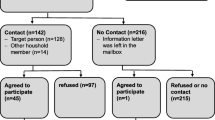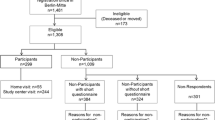Abstract
The Heinz Nixdorf Recall Study is an ongoing population-based prospective cardiovascular cohort study of the Ruhr area in Germany. This paper focuses on the recruitment strategy and its response results including a comparison of participants of the baseline examination with nonparticipants. Random samples of the general population were drawn from residents’ registration offices including men and women aged 45–74 years. We used a multi-mode contact approach including an invitational letter, a maximum of two reminder letters and phone calls for the recruitment of study subjects. Nonparticipants were asked to fill in a short questionnaire. We calculated proportions of response, contact, cooperation and recruitment efficacy to characterize the participation. Overall, 4487 eligible subjects participated in our study. Although the elderly (65–75 years) had the highest contact proportion, the cooperation proportion was the lowest among both men and women. The recruitment efficacy proportion was highest among subjects aged 55–64 years. The identifiability of the phone number of study subjects was an important determinant of response. The recruitment efficacy proportion among subjects without an identified phone number was 11.4% as compared to 65.3% among subjects with an identified phone number. The majority of subjects agreed to participate after one invitational letter only (52.6%). A second reminding letter contributed only very few participants to the study. Nonparticipants were more often current smokers than participants and less often belonged to the highest social class. Living in a regular relationship with a partner was more often reported among participants than nonparticipants.
Similar content being viewed by others
Abbreviations
- EBT:
-
electron beam computed tomography
References
R Doll R Peto (1976) ArticleTitleMortality in relation to smoking: 20 years’ observations on male British doctors Br Med J 2 IssueID6051 1525–1536 Occurrence Handle1:STN:280:CSiD1cfns1Y%3D Occurrence Handle1009386
CH Hennekens JE Buring R Peto (1992) ArticleTitleAspirin in ischemic heart disease N Engl J Med 327 1455–1456 Occurrence Handle1:STN:280:ByyD38vnvFM%3D
F Grodstein ME Martinez EA Platz E Giovannucci GA Colditz M Kautzky C Fuchs MJ Stampfer (1998) ArticleTitlePostmenopausal hormone use and risk for colorectal cancer and adenoma Ann Intern Med 128 705–712 Occurrence Handle1:STN:280:DyaK1c3htlaltg%3D%3D Occurrence Handle9556463
A Stang W Ahrens KH Jöckel (1999) ArticleTitleControl response proportions in population-based case-control studies in Germany Epidemiology 10 181–183 Occurrence Handle1:STN:280:DyaK1M7ms1OrtA%3D%3D Occurrence Handle10069256
A Schmermund S Möhlenkamp A Stang D Grönemeyer R Seibel H Hirche K Mann W Siffert K Lauterbach J Siegrist KH Jöckel R Erbel (2002) ArticleTitlefor the Heinz Nixdorf Recall Study Investigative Group. Assessment of clinically silent atherosclerotic disease and established and novel risk factors for predicting myocardial infarction and cardiac death in healthy middle-aged subjects: rationale and design of the Heinz Nixdorf Recall Study Am Heart J 144 212–218 Occurrence Handle12177636
ML Slattery SL Edwards BJ Caan RA Kerber JD Potter (1995) ArticleTitleResponse rates among control subjects in case-control studies Ann Epidemiol 5 245–249 Occurrence Handle1:STN:280:ByqA3s%2FhsVU%3D Occurrence Handle7606315
U Latza A Stang M Bergmann A Kroke S Sauer R Holle P Kamtsiuris C Terschüren W Hoffmann (2004) ArticleTitleThe problem of response in epidemiological studies in Germany (part I) [Zum Problem der Response in epidemiologischen Studien in Deutschland (Teil I)] Gesundheitswesen 66 326–336 Occurrence Handle1:STN:280:DC%2BD2c3ktF2lsQ%3D%3D Occurrence Handle15141353
W Thefeld H Stolzenberg BM Bellach (1999) ArticleTitleThe Federal Health Survey: response, composition of participants and non-responder analysis Gesundheitswesen 61 S57–S61 Occurrence Handle10726397
E Rabe E Pannier-Fischer K Bromen K Schuldt A Stang C Poncar M Wittenhorst E Bock S Weber KH Jöckel (2003) ArticleTitleBonn Vein study of the German Society of Phlebology [Bonner Venenstudie der Deutschen Gesellschaft für Phlebologie] Phlebologie 32 1–14
H Boeing A Korfmann MM Bergmann (1999) ArticleTitleRecruitment procedures of EPIC-Germany Ann Nutr Metab 43 205–215 Occurrence Handle1:CAS:528:DyaK1MXotFygtbw%3D Occurrence Handle10592369
W Hoffmann C Terschüren R Holle P Kamtsiuris M Bergmann A Kroke S Sauer A Stang U Latza (2004) ArticleTitleThe problem of response in epidemiologic studies in Germany (part II) [Zum Problem der Response in epidemiologischen Studien in Deutschland (Teil II)] Gesundheitswesen 66 482–491 Occurrence Handle1:STN:280:DC%2BD2cvmtFegtg%3D%3D Occurrence Handle15372348
LB Cottler JF Zipp LN Robins EL Spitznagel (1987) ArticleTitleDifficult-to-recruit respondents and their effect on prevalence estimates in an epidemiologic survey Am J Epidemiol 125 329–339 Occurrence Handle1:STN:280:BiiC38vns1U%3D Occurrence Handle3812439
KM Bisgard AR Folsom CP Hong TA Seller (1994) ArticleTitleMortality and cancer rates in nonrespondents to a prospective study of older women: 5-year follow-up Am J Epidemiol 139 990–1000 Occurrence Handle1:STN:280:ByuB3svhtVY%3D Occurrence Handle8178787
J Vestbo FV Rasmussen (1992) ArticleTitleBaseline characteristics are not sufficient indicators of non-response bias in follow-up studies J Epidemiol Community Health 46 617–619 Occurrence Handle1:STN:280:ByyC2MrmtFI%3D Occurrence Handle1494079
J Brogger P Bakke GE Eide A Gulsvik (2003) ArticleTitleContribution of follow-up of nonresponders to prevalence and risk estimates: a Norwegian respiratory health survey Am J Epidemiol 157 558–566 Occurrence Handle12631547
VL Holt JR Daling A Stergachis LF Voigt NS Weiss (1991) ArticleTitleResults and effect of refusal recontact in a case-control study of ectopic pregnancy Epidemiology 2 375–379 Occurrence Handle1:STN:280:By2D2srotVA%3D Occurrence Handle1742389
LJ Launer AW Wind DJ Deeg (1994) ArticleTitleNonresponse pattern and bias in a community-based cross-sectional study of cognitive functioning among the elderly Am J Epidemiol 139 803–812 Occurrence Handle1:STN:280:ByuB3svhtFQ%3D Occurrence Handle8178793
M Akker ParticleVan den F Buntinx JFM Metsemakers JA Knotterus (1998) ArticleTitleMorbidity in responders and non-responders in a register-based population survey Family Prac 15 261–263
L Richiardi P Boffetta F Merletti (2002) ArticleTitleAnalysis of nonresponse bias in a population-based case-control study on lung cancer J Clin Epidemiol 55 1033–1040 Occurrence Handle12464380
A Barchielli D Balzi (2002) ArticleTitleNine-year follow-up of a survey on smoking habits in florence (Italy): higher mortality among non-responders Int J Epidemiol 31 1038–1042 Occurrence Handle12435781
MA Austin MH Criqui E Barrett-Connor MJ Holdbrook (1981) ArticleTitleThe effect of response bias on the odds ratio Am J Epidemiol 114 137–143 Occurrence Handle1:STN:280:Bi6B38bksFc%3D Occurrence Handle7246521
G Boström J Hallqvist BJ Haglund A Romelsjö L Svanström F Diderichsen (1993) ArticleTitleSocioeconomic differences in smoking in an urban Swedish population. The bias introduced by non-participation in a mailed questionnaire Scand J Soc Med 21 77–82 Occurrence Handle8367686
K Korkeila S Suominen J Ahvenainen A Ojanlatva P Rautava H Helenius M Koskenvuo (2001) ArticleTitleNon-response and related factors in a nation-wide health survey Eur J Epidemiol 17 991–999 Occurrence Handle1:STN:280:DC%2BD38nit1Gmsw%3D%3D Occurrence Handle12380710
A Stang (2003) ArticleTitleNonresponse research – an underdeveloped field in epidemiology (editorial) Eur J Epidemiol 18 929–931 Occurrence Handle14598921
A Stang KH Jöckel (2004) ArticleTitleStudies with low response proportions may be less biased than studies high response proportions Am J Epidemiol 159 204–210 Occurrence Handle14718223
P Hartge (1999) ArticleTitleRaising response rates: getting to yes Epidemiol 10 105–106 Occurrence Handle1:STN:280:DyaK1M7ms1OksA%3D%3D
Author information
Authors and Affiliations
Additional information
on behalf of the Heinz Nixdorf Recall Study Investigative Group
Rights and permissions
About this article
Cite this article
Stang, A., Moebus, S., Dragano, N. et al. Baseline recruitment and analyses of nonresponse of the Heinz Nixdorf recall study: Identifiability of phone numbers as the major determinant of response. Eur J Epidemiol 20, 489–496 (2005). https://doi.org/10.1007/s10654-005-5529-z
Accepted:
Issue Date:
DOI: https://doi.org/10.1007/s10654-005-5529-z




